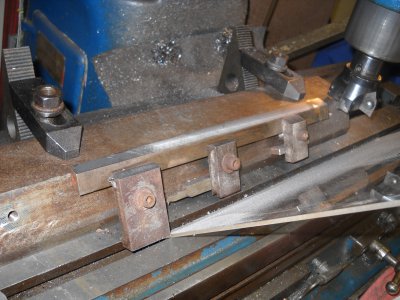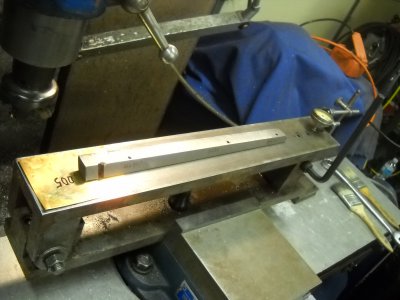I need to make a new table gib for a small Douglas horizontal mill. The table is 8 x 32 and the old gib is 16” long. I have a 18” piece of cast iron I cut from an old vice that I plan on using for the gib. This is a tapered gib and the dovetails are 55 degrees. The taper looks to be about 1/8” per foot. I have a question on the order of operations. Should I cut the taper first or the 55 degree bevel on the edges? Or does it matter?
-
Welcome back Guest! Did you know you can mentor other members here at H-M? If not, please check out our Relaunch of Hobby Machinist Mentoring Program!
You are using an out of date browser. It may not display this or other websites correctly.
You should upgrade or use an alternative browser.
You should upgrade or use an alternative browser.
New gib for Douglas mill
- Thread starter lou0524
- Start date
4
4GSR
Forum Guest
Register Today
Cut the 55 deg. first. (easier said than done).
I have a fixture that has a 30 deg angle machined on it that I use for making gibs for 60 deg. dovetails. I'll try to attach a picture of the jig. Once you machine the 55 degrees on the two surfaces, use a adjustable angle table to get the proper taper machined on the gib. Again easier said than done. I generally drill and tap holes in the gib to secure it to the angle plate. The holes can be filled with metal epoxy after machining. Once you get the gib machined as close as you can, it will have to be scrape and fitted to the slide.


I have a fixture that has a 30 deg angle machined on it that I use for making gibs for 60 deg. dovetails. I'll try to attach a picture of the jig. Once you machine the 55 degrees on the two surfaces, use a adjustable angle table to get the proper taper machined on the gib. Again easier said than done. I generally drill and tap holes in the gib to secure it to the angle plate. The holes can be filled with metal epoxy after machining. Once you get the gib machined as close as you can, it will have to be scrape and fitted to the slide.


- Joined
- Dec 26, 2012
- Messages
- 63
I need to make a new table gib for a small Douglas horizontal mill. The table is 8 x 32 and the old gib is 16” long. I have a 18” piece of cast iron I cut from an old vice that I plan on using for the gib. This is a tapered gib and the dovetails are 55 degrees. The taper looks to be about 1/8” per foot. I have a question on the order of operations. Should I cut the taper first or the 55 degree bevel on the edges? Or does it matter?
Hi there,
Jan Sverre here.
Why do you have to make a new one. What kind of damage?
Cut the 55 deg. first. (easier said than done).
I have a fixture that has a 30 deg angle machined on it that I use for making gibs for 60 deg. dovetails. I'll try to attach a picture of the jig. Once you machine the 55 degrees on the two surfaces, use a adjustable angle table to get the proper taper machined on the gib. Again easier said than done. I generally drill and tap holes in the gib to secure it to the angle plate. The holes can be filled with metal epoxy after machining. Once you get the gib machined as close as you can, it will have to be scrape and fitted to the slide.
I have a couple of real strong magnets (they are off of a main frame computer disk drive) that I am going to try and use to cut the taper. These magnets are super strong. I have to use a tire iron in the t slot to pry them off the table. They are 3”x 5”x 7 ½” . If I lay them length wise along the x axis over 80% of the gib will be supported. I can mount the old gib below the new one and indicate it in , so I should have no trouble duplicating the taper. If I take very light cuts I think I will be ok. If not I will try your method with the tapped holes and the angle plate. Thanks for the help.
Lou
Hi there,
Jan Sverre here.
Why do you have to make a new one. What kind of damage?
Jan,
I have no more adjustment on the gib. Someone had already put a .005 shim behind it before I got it. I pulled the table to replace the worm for the table drive so I thought I would make a new gib while I was at it.
Lou
4
4GSR
Forum Guest
Register Today
Lou,
If the gib is in good shape, it's not unusual to go in and replace the .005" shim with a thicker shim. A .010 or .015" thick shim will probably be a perfect fit. I have done this too. In fact, the pictures I posted, the gib I was reconditioning had a .125" shim added. Of course the gib was in bad shape and it took a lot of fixing to get it usable. I should have made a new one but didn't.
Ken
If the gib is in good shape, it's not unusual to go in and replace the .005" shim with a thicker shim. A .010 or .015" thick shim will probably be a perfect fit. I have done this too. In fact, the pictures I posted, the gib I was reconditioning had a .125" shim added. Of course the gib was in bad shape and it took a lot of fixing to get it usable. I should have made a new one but didn't.
Ken
Lou,
If the gib is in good shape, it's not unusual to go in and replace the .005" shim with a thicker shim. A .010 or .015" thick shim will probably be a perfect fit. I have done this too. In fact, the pictures I posted, the gib I was reconditioning had a .125" shim added. Of course the gib was in bad shape and it took a lot of fixing to get it usable. I should have made a new one but didn't.
Ken
I also want to get some scraping practice.
Lou
